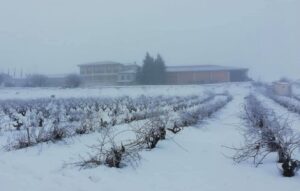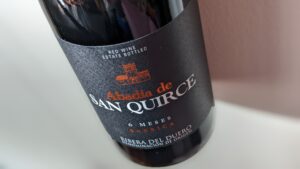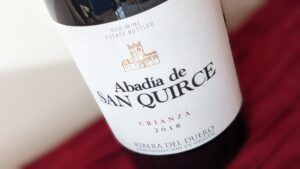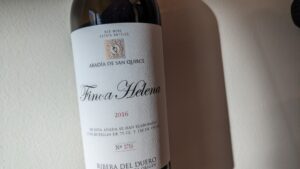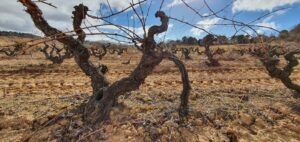
Photo Credit: Abadía San Quirce
José Antolín grew up in a small village in Spain, home of only a few hundred people during the 1930s to 1950s; even today, only around 250 people still reside there. Like many of their neighbors, his family was dirt poor as there was very little work and just simply putting food on the table was a constant weekly challenge. Almost an hour away, in the historical city of Burgos, there was an opportunity for the Antolín family to open a garage to repair cars and tractors as many wheat farmers surrounded the town as well as a booming industrial economy existed where many inhabitants were making a good living. In 1950, José and his brother invented the rubber-metal steering joints in automobiles helping to prolong the life of this component; fast-forward to today, the family’s company, Antolín Group, a Spanish multinational company that designs and manufactures parts for the interiors of cars, has sales that are in the billions of dollars as well as has their components in nine of the ten best-selling vehicles in the world.
But through time, the rural way of life that was being threatened started to concern José Antolín. He was afraid that many small villages, such as the one he grew up in, may vanish and industrial agriculture would take over the land. And so his deep love for the century-old Tempranillo bush vines that existed in the Ribera del Duero wine region, which surrounds the enchanting city of Burgos – extending out west and east – would lead him with three other business partners to start the wine company Bodegas Imperiales in 1998.
José named the winery Abadía San Quirce after the 12th-century abbey that he bought in the area and the name of the winery is a symbol of his fierce commitment to protecting the history of his homeland. Through time, José bought out the other owners so he could solely run Abadía San Quirce as he was fiercely passionate about keeping the old ways of farming the vines, which didn’t make financial sense, and he is keeping alive a technique called ‘layering‘ that allows the century-old vines to live on, in some sense, indefinitely.
Abadía San Quirce in Ribera del Duero
Abadía San Quirce sources fruit from vineyards they own themselves as well as working with multi-generational growers, and almost 20% of the vines they work with are over 100 years old pre-phylloxera vines. Pre-phylloxera vines are rare, precious gems nowadays as many vines worldwide have to be grafted on American rootstock to combat the phylloxera louse that devastated the vineyards of Europe in the mid-19th century; hence working with some of the oldest vines in Ribera del Duero, Spain.

Photo Credit: Abadía San Quirce
But the old technique of layering will allow these century-old vines to live on past their own lifespan. Grapevines can asexually reproduce, and so if one buries a shoot coming off of an existing century-old vine right next to it, the buried shoot will be able to grow roots from the buds dormant in that shoot. Through time, a vine, which will be trellised as a bush vine, will grow and be an extension of that century-old vine. The mother (original 100-year-old vine) and the new daughter vine (produced from the mother’s shoot) will stay connected as long as needed, according to Abadía San Quirce winemaker Diana Moreno Grávalos. But sometimes, the shoot is cut if the daughter vine has reached enough maturity to have deep roots, yet it will always be as close as a vine can get to that mother vine when it comes to its DNA. Diana notes that their old vines are part of the expression of their terroir (sense of place) and so going to these great lengths to keep some part of these century-old vines alive, even in another century, is essential to Abadía San Quirce.
Diana said that the old vines produce significantly lower yields and the grapes are much more concentrated and complex – expressing more sense of place than the younger vines – yet there is an added benefit of their high drought and disease tolerance. She even experiences these qualities in their other vines that range between 50 to 65 years old and says the wine produced from these older vines is more “balanced” than what is made from younger vines. Abadía San Quirce likes to bottle their “youngest vines” in their own bottling as the grapes have much more fruit expression that can be enjoyed younger, however, the youngest vines they use are at a good maturity of being between 15 to 25 years old, which is remarkable considering many other wine producers around the world view vines to be at the end of their life at 25 years old instead of the beginning.
Whether owned by Abadía San Quirce or sourced by family growers, all of the vineyards are only managed by hand without any mechanical assistance, as it is the best way to avoid harming the old vines. All of their vines are bush vines that are buried directly into the ground without using any foreign rootstocks, as they do not fear the louse phylloxera destroying the roots or base of the plants since they have sandy soils in their vineyards which phylloxera doesn’t like. “Every vine we plant has the intention of it becoming a century-old vine one day”, explained Diana.
Living on in the Vines
The far-off past becomes more vivid as one gets older, and the immediate present starts to fade into the background. Maybe it is because when one no longer has to work long hours to build and sustain something of significance for his family, he can rest and reflect on the values passed on to him as a child.
There were many tough times for José Antolín growing up poor in a sparsely populated rural village but there were also beautiful moments of a community coming together to maintain those precious aspects of their village such as the sweat and blood that were given in the care of these bush vines, so those same plants could be passed on to their great-great grandchildren and beyond.
And so, even though José Antolín, has given back to his larger community in his province a thousand times over by building an automobile component business that has created jobs, resources and opportunities, he has never forgotten about the tiny farming villages that represent the heart and soul of his family. And so he is doing everything in his power to make sure that the people of these rural towns have a reason to stay and can pass down the old vines for centuries to come… making sure that the sacrifices of past generations don’t die so quickly but instead are always there to remind the future locals who they are, where they came from and the pride that comes from being rooted in such a place.
***This article was originally published on Forbes: https://www.forbes.com/sites/cathrinetodd/2022/03/10/top-wine-region-in-spain-using-old-technique-of-layering-century-old-vines/
All of the Abadía San Quirce wines are made from bush vine Tempranillo – known at Tinta del País in the villages where their vineyards are located in Ribera del Duero. They only use their estate vineyards, or family vineyards that they have helped manage for decades, they will never buy grapes from any other vineyards even if yields are meager due to frost. Most of the vineyards are around 2,600 feet (800 meters) in elevation and mainly made up of sandy soils that bring an “elegance” to their wines, according to winemaker Diana Moreno Grávalos.
2020 Abadía San Quirce ‘6 Meses’ Ribera del Duero: 100% bush vine Tempranillo that range between 20 to 25 years old – some of their youngest vines. A deliciously generous wine with notes of dried blueberries and red currant preserves with hints of cinnamon bark and a round body with a juicy finish. It is only aged six months in oak and hence the name.
2018 Abadía San Quirce, Crianza, Ribera del Duero: 100% bush vine Tempranillo that average around 40 years old. Dusty rock with pretty red strawberry fruit and good mid-palate weight with an intriguing note of sandalwood incense with a fine texture.
2016 Abadía San Quirce, Reserva, Ribera del Duero: 100% bush vine Tempranillo that average around 50 years old. The Reserva is not released yet and so this is a preview bottling. Complex nose of fresh leather, black olive and rich cassis with tighter tannins and deeper concentration – built to age.
2019 Abadía San Quirce ‘M9’ Ribera del Duero: 100% bush vine Tempranillo that are 65 years old. This is a single vineyard site made in small quantities, and the vineyard is located 920 meters (over 3,000 feet) in elevation, hence why it is called ‘M9’. This wine has more of a Continental quality since the temperatures are a lot cooler in this vineyard, and so it has an intense minerality and marked acidity with notes of granite and blackcurrant leaf and a long aromatic, expressive finish.
2016 Abadía San Quirce ‘Finca Helena’ Ribera del Duero: 100% bush vine Tempranillo from vines that are over 100 years old. This is another single vineyard made in small quantities that has been isolated and has a unique expression. The winemaker Diana Moreno Grávalos said that there might be other sites that they start to separate to do more single-vineyard bottlings in the future. This wine is much deeper and darker than the ‘M9’ with brooding blackberry fruit and hints of blueberry scones with a mineral edge that has hints of broken limestone notes with a big body that has brawny tannins with a lovely silky quality, so although it is a wine with a lot of structure, it has a fine quality that caresses the palate.

